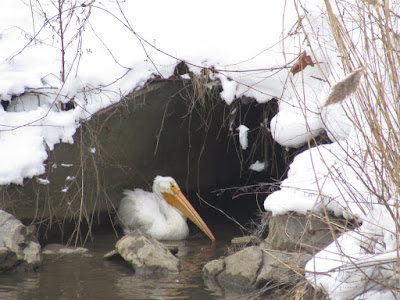Nature Note #157: A Pelican in Syracuse
As crazy as it sounds, the Inner Harbour of Lake Onondaga in Syracuse has been graced with an unusual winter visitor in recent weeks. While the usual reports of Glaucous (Larus hyperboreus) or Iceland Gulls (L. glaucoides) swirled about on the listservs, few surprses seemed likely. That all changed to sudden pandemonium, as local birders erupted online with talk of an American White Pelican (Pelecanus erythrorhynchos) spotted on Lake Onondaga in mid January!
Alison and I were lucky enough to see this rare visitor (and a possible first for the county in winter) yesterday, before heading up to watch the feeders at Beaver Lake Nature Center in Baldwinsville. After spotting some local birders watching a culvert under the bridge supporting Spencer Street, we were rewarded with an excellent view of this huge white bird.
As we watched it emerge from the culvert, its massive pouched bill swelled and shivered. It didn't seem to mind the 20 degree weather as we shivered ourselves, clicking pictures and writing out notes with bare hands. Several Mallards (Anas platyrhynchos) watched calmly as it continue to corral small fish in and out of the culvert.
While many may think of pelicans as tropical birds living on white sand beaches surrounded by palm trees, but they live in many temperate regions of the world. The Brown Pelican (P. occidentalis) can wander as far north as British Colombia and Nova Scotia, while live specimens of the enormous Great White Pelican (P. onocrotalis) can be found living year round in London's St. James Park.
At least to me, it doesn't seem that unusual that an American White Pelican wouldn't be that bothered by the cold. According to Cornell's All About Birds, they breed in parts of the open prairie of Alberta, Saskatchewan, and Manitoba were I imagine, it can get very cold during the winter months. However, they spend their time up there during the spring breeding season when temperatures are much warmer. This begs the question; what is it doing here?
One possibility is that a storm could have blown it off course causing it to inadvertently head north rather than south. This is more common for young and therefore more inexperienced birds than adults, but if the winds were strong enough, it could have happened to any bird at any age. As a result, it searched for a body of water to rest and refuel and fortunately for us birders, it chose Lake Onondaga.
Without those other eagle-eyed birders, we would have probably headed up to Beaver Lake empty handed. Indeed, what a wonder to behold during this blustery winter weather!
Alison and I were lucky enough to see this rare visitor (and a possible first for the county in winter) yesterday, before heading up to watch the feeders at Beaver Lake Nature Center in Baldwinsville. After spotting some local birders watching a culvert under the bridge supporting Spencer Street, we were rewarded with an excellent view of this huge white bird.
As we watched it emerge from the culvert, its massive pouched bill swelled and shivered. It didn't seem to mind the 20 degree weather as we shivered ourselves, clicking pictures and writing out notes with bare hands. Several Mallards (Anas platyrhynchos) watched calmly as it continue to corral small fish in and out of the culvert.
While many may think of pelicans as tropical birds living on white sand beaches surrounded by palm trees, but they live in many temperate regions of the world. The Brown Pelican (P. occidentalis) can wander as far north as British Colombia and Nova Scotia, while live specimens of the enormous Great White Pelican (P. onocrotalis) can be found living year round in London's St. James Park.
At least to me, it doesn't seem that unusual that an American White Pelican wouldn't be that bothered by the cold. According to Cornell's All About Birds, they breed in parts of the open prairie of Alberta, Saskatchewan, and Manitoba were I imagine, it can get very cold during the winter months. However, they spend their time up there during the spring breeding season when temperatures are much warmer. This begs the question; what is it doing here?
One possibility is that a storm could have blown it off course causing it to inadvertently head north rather than south. This is more common for young and therefore more inexperienced birds than adults, but if the winds were strong enough, it could have happened to any bird at any age. As a result, it searched for a body of water to rest and refuel and fortunately for us birders, it chose Lake Onondaga.
Without those other eagle-eyed birders, we would have probably headed up to Beaver Lake empty handed. Indeed, what a wonder to behold during this blustery winter weather!





Comments
Post a Comment